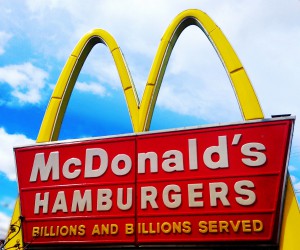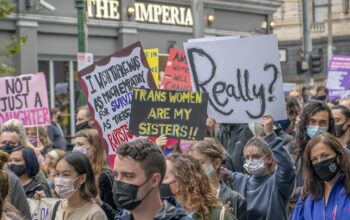It is one of the largest restaurant chains in the world spanning 116 countries, 34,000 restaurants and employing 1.8 million people worldwide. McDonald’s has become synonymous with fast food and the brand has infiltrated the world. My own experience with the fast food giant is somewhat different. In my home country of Trinidad and Tobago, McDonald’s was reintroduced only two years ago after closing down in 2003 due to low sales. As for their hefty human resources total of 1.8 million employees, that figure trumps the entire population of my country. Yet there is more to the chain’s story than enabling millions of fast food junkies. Behind the golden arches logo lays a deeper association that many of us tend to ignore when biting into a juicy Big Mac. The fast food royalty can be tied to more profound claims of modernity representation, cultural imperialism and global consumerism.
The global reach of the company was confirmed when “The Big Mac Index” was first propelled to fame in 1986. The Economist suggested that the value of national currencies could be measured by comparing the prices of a Big Mac across the globe. The term is still used to this day making economic theory easier to understand for the everyday man and giving tourists a benchmark for the cost of living in their desired destinations. A few years later, in 1996, Thomas Friedman put forth his theory, riddled with satire, suggesting that no two countries that were home to a McDonald’s franchise had ever gone to war with each other. According to Friedman “…people in McDonald’s countries don’t like to fight wars; they like to wait in line for burgers.” As ridiculous as the theory sounded, at the time it was found to be true. In 1999, however, the war between India and Pakistan over Kashmir refuted the theory.
The entrance of the fast food dynasty is symbolic of a host country’s entry into the global capitalist market and its unification with the rest of the world. It can be seen as a symbol of reaching modernity and attaining a stable economy. Vietnam is the newest  member of the Big Mac joining this month on February 8 with its first restaurant in Ho Chi Minh City. The New York Times reported on the fast food chain’s introduction in the Vietnamese market, claiming “It was inevitable, consultants said, that more American brands would enter the country once the economics looked more appealing. Vietnam’s per capita income rose to $1,550 in 2012 from $1,000 in 2008, according to World Bank estimates, and inflation has stabilized.” The new franchise owners of McDonald’s Trinidad and Tobago is Arcos Dorados, the largest McDonald’s franchisee in the world in terms of system- wide sales and number of restaurants. Trinidad marketing manager for Arcos Dorados, Milagros Bermudez, remarked on the Trinidadian economy stating, “We discovered that it was pretty stable here. Also, it’s amazing all the options that local people have here and we were missing that. Trinidad is very important to us and we are looking forward in investing in this island. The money we have invested in this process… we don’t put a number. We are sure we’ll make it back.”
member of the Big Mac joining this month on February 8 with its first restaurant in Ho Chi Minh City. The New York Times reported on the fast food chain’s introduction in the Vietnamese market, claiming “It was inevitable, consultants said, that more American brands would enter the country once the economics looked more appealing. Vietnam’s per capita income rose to $1,550 in 2012 from $1,000 in 2008, according to World Bank estimates, and inflation has stabilized.” The new franchise owners of McDonald’s Trinidad and Tobago is Arcos Dorados, the largest McDonald’s franchisee in the world in terms of system- wide sales and number of restaurants. Trinidad marketing manager for Arcos Dorados, Milagros Bermudez, remarked on the Trinidadian economy stating, “We discovered that it was pretty stable here. Also, it’s amazing all the options that local people have here and we were missing that. Trinidad is very important to us and we are looking forward in investing in this island. The money we have invested in this process… we don’t put a number. We are sure we’ll make it back.”
Key to the success of the chain is its precise marketing schemes that not only tap into the native markets but covert local tastes to favour Western–styled fast food. Techniques used by McDonald’s to establish their brand locally include the adoption of local flavours and dishes to their menu. For example in India, there are no beef products on the menu due to the prevalence of Hinduism. Instead, patrons can purchase a McAloo Tikki Sandwich where the typical burger patty is swapped for a potato alternative. Some may admire this approach taken by the corporation and applaud it as cultural sensitivity. However, some may consider this infiltration a mark of cultural imperialism. The new type of food offered by the outlet can be viewed as modern and fashionable, which may mean trouble for local vendors and home cooking. According to Markus Taussig, an assistant business professor at the National University of Singapore and a former Vietnam resident, “McDonald’s in Vietnam is going to be packed with parents, many of whom will not be eating because the food doesn’t appeal to them but who will be happy because watching their kids munch away on burgers makes them feel they’re part of something positive and modern.”
The secret sauce to the success of the food chain is not only its marketing strategy but also its combination with mounting global consumerism. Globalisation has encouraged not only quick and easy travel and open markets but its effect has manifested a global culture of fast food fixes and global Happy Meals. The trend is now toward the development of a universal culture and although the space between civilisations is closing, the bridge is being made of fries and not as a product of real cultural exchange.
So how is McDonald’s coping in Trinidad and Tobago? Over the last two years, five new McDonald’s restaurants have been opened in the country and business seems to be flourishing in the island whose area totals 5,128 km². In true McDonald’s fashion, the marketing scheme by the new Latin American franchise holder,  Arcos Dorados, incorporated local appreciation for spices and offered novel services. McCafé fulfils coffee needs, Auto Mac allows for “drive-thru” access, PlayPlace offers an area for children’s entertainment and the DessertCentre satisfies sweet tooth cravings. Additionally the chain offers the “Fresh” line of menu items that provides healthier alternatives such as salads and fruit with Happy Meals. The same company thus satisfies the needs of multiple patrons with varying tastes. I wondered how we ever survived before their arrival and then I remembered – we cooked most of our food at home, we rarely drank coffee in 35 degree Celsius weather, our children played outside in the savannahs and dessert was centred around homemade coconut ice cream.
Arcos Dorados, incorporated local appreciation for spices and offered novel services. McCafé fulfils coffee needs, Auto Mac allows for “drive-thru” access, PlayPlace offers an area for children’s entertainment and the DessertCentre satisfies sweet tooth cravings. Additionally the chain offers the “Fresh” line of menu items that provides healthier alternatives such as salads and fruit with Happy Meals. The same company thus satisfies the needs of multiple patrons with varying tastes. I wondered how we ever survived before their arrival and then I remembered – we cooked most of our food at home, we rarely drank coffee in 35 degree Celsius weather, our children played outside in the savannahs and dessert was centred around homemade coconut ice cream.
It would seem that the cost of diminishing local cultures by capitalist incentives could be found on the Dollar Menu. Although the effects of fast food chains around the world are discreet, they are still present. We really do need to ask ourselves “Am I Lovin’ It?”
By Marise Ayoung
Image credit:
Picture 1&2: Mike Mozart, licensed under CC BY 2.0






